Advertisement
Corrosion damage can be as simple as a pitted prop or as serious as a destroyed outdrive. Follow a few simple rules to prevent most types of corrosion.
Most insurance policies exclude corrosion damage. However, according to BoatUS Marine Insurance claims files, corrosion is directly responsible for some claims you might not have expected, including boats sunk from corrosion-damaged thru-hull fittings. There have even been reports of accidents caused by a corroded steering fitting that failed underway.
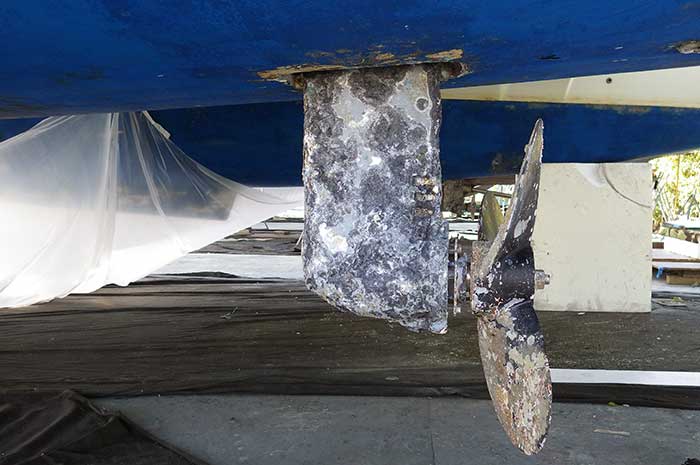
Improperly maintained saildrives are notorious for corrosion problems, but it doesn't have to be this way. A little bit of knowledge and the proper protection will keep your underwater metals happy and long-lived. (Photo: BoatUS Marine Insurance)
Boaters must understand what corrosion is and know how to protect a boat from it. Misinformation abounds, with many self-proclaimed experts ascribing unexpected metal and bottom-paint damage to vague descriptions of "electrolysis," "hot marinas," or "electricity in the water." The root causes of virtually all cases of "sudden and unexpected damage" are, in fact, inattention, improper materials, and poor system design. Let's look at the types of corrosion that happen to underwater metals on recreational watercraft and consider what you can do about it.
Problem No. 1: Galvanic Corrosion
Galvanic corrosion occurs naturally whenever two dissimilar metals, such as steel and bronze, are in contact with each other and wetted with a common electrolyte, such as seawater. No external voltage source is required to cause this corrosion damage as the chemical properties of the metals and the electrolyte produce an electrical current flow between the two metals and through the electrolyte. The metals don't even have to be submerged in the electrolyte; saltwater merely wetting the metal-on-metal connection can result in galvanic corrosion; for example, corrosion damage to an aluminum frame in close proximity to a stainless-steel fastener is galvanic corrosion.
Galvanic Series In Flowing Seawater
Ag/AgC1 reference; flow rate 2 to 4 meters/sec; 10° C to 26° C
| Metal | Potential in millivolts |
|---|---|
| Magnesium & Alloys | -1,600 to -1,630 |
| Zinc | -980 to -1,030 |
| Aluminum Alloys | -760 to -1,000 |
| Mild Steel | -600 to -710 |
| Stainless Steels (active in still water) | -460 to -580 |
| Aluminum Bronze | -310 to -420 |
| Nibral | -310 to -420 |
| Brasses | -300 to -400 |
| Tin | -310 to -330 |
| Copper | -300 to -570 |
| Silicon Bronze | -260 to -290 |
| Bronzes | -240 to -310 |
| Copper Nickel (90/10) | -210 to -280 |
| Copper Nickel (70/30) | -180 to -230 |
| Lead | -190 to -250 |
| 304 Stainless Steel (Passive) | -50 to -100 |
| Monel 400 | -40 to -140 |
| 316 Stainless Steel (Passive) | 00 to -100 |
| Graphite | +200 to +300 |
The chemically produced electrical current will cause the "less-noble" (more likely to be damaged) metal to corrode (or sacrifice) while protecting the "more-noble" (less likely to be damaged) metal from corrosion. The galvanic series (see the "Galvanic series in flowing seawater" table above) will show which metals will sacrifice and which will be protected if connected while in contact with seawater. If three or more metals are interconnected and the surface area of the least-noble metal is large enough, then this least-noble metal will sacrifice itself and "protect" all the others. This is why galvanic corrosion can be easily controlled through the use of sacrificial anodes, called "cathodic protection." However, if the anode area exposed to seawater is insufficient to produce the galvanic current necessary for adequate protection, or if the anode becomes depleted, the next least-noble metal will also begin to corrode. For example, if the zinc anodes on an aluminum saildrive are not maintained, the aluminum will begin to sacrifice itself around stainless-steel fasteners or its bronze propeller. Likewise, if a boat with a properly installed safety ground is connected to shore power without a galvanic isolator or isolation transformer, then its anodes (and submerged metals) can actually protect the submerged metals connected to the dock.
Galvanic corrosion is not a significant problem if compatible metals (ones located near each other on the galvanic series) are used and/or a properly designed cathodic protection system is installed, monitored, and maintained. Cathodic bonding system wires have to be installed on fiberglass boats to interconnect the various metal thru-hull fittings and running gear. Another approach is to keep incompatible metals from touching each other and simply rely on their own corrosion resistance. This works if great care is taken with the selection of metals and they have their own anodes if needed. Trim tabs and IPS pod drives are examples of this approach.
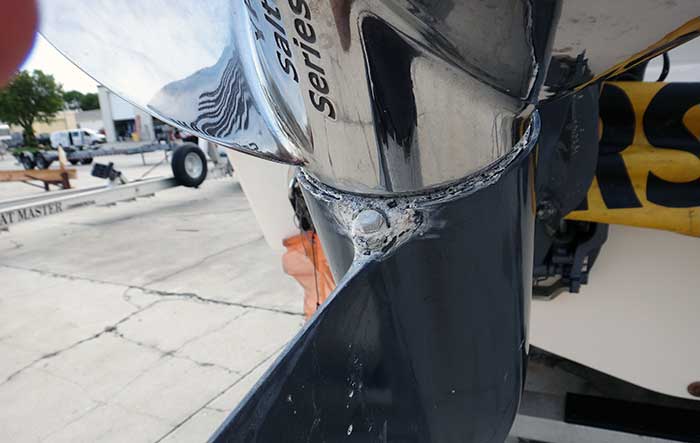
This aluminum lower unit has a large stainless steel prop. Without proper cathodic protection, the aluminum housing will corrode. (Photo: James Coté)
For boaters, using anodes is how we protect against galvanic corrosion. Without them, your underwater metals can disintegrate, and you'll be on the hook for the repairs because insurance typically doesn't cover corrosion damage itself. Magnesium anodes can be used for cathodic protection and perform well in freshwater applications, but they damage bottom paint and can actually cause cathodic-corrosion damage to aluminum when used in seawater. Too many zinc anodes can also damage some types of bottom paint in extreme conditions but won't damage underwater metals. Aluminum-alloy anodes (a different alloy than that used in manufacturing aluminum hulls, outboards, and outdrives) are more efficient than zinc, lighter than zinc, and work in freshwater, seawater, or brackish water without damaging aluminum or bottom paint. Aluminum anodes probably will soon become the industry standard, and I recommend them.
Tip
Impressed-current systems utilize onboard electrical power sources to produce the currents necessary for cathodic protection. They're relatively more expensive to install initially but require less maintenance. When they work, they work extremely well; when they fail, they can fail big. Keep in mind, no cathodic protection system can protect internal piping, strainers, or bilge areas.
Far and away, the most common cause of rapid anode loss and accelerated metal damage below the waterline is galvanic current flow back to the dock. Just think of all the submerged metals connected to the dock ground; every boat that shares a grounded shore-power cord is connected to the others. Sacrificial anodes, such as zinc and aluminum, typically aren't large enough to protect all of these metals, as the cathodic current to protect the entire dock could be huge. Fortunately, a shore-power galvanic isolator or an isolation transformer can be used to block the galvanic current between boat and dock, eliminating the problem.
For an investment of about $200, you can make sure your vessel has adequate cathodic protection. Go to BoatUS.com/Corrosion-Test for a complete explanation.
Special Issues With Aluminum
Although aluminum is a very light and strong metal, with certain alloys performing very well in seawater environments, aluminum alloys are susceptible to galvanic corrosion when coupled with other metals. Galvanic current to the dock can be the kiss of death for aluminum outboards, outdrives, and sail drives, particularly if the owner uses the oil sheen on the water as his indicator that he should check his zincs!
Aluminum sail drives are especially susceptible to corrosion damage, mostly because they're out of sight and, thus, out of mind. Checking a sail drive's anodes once a season may not be sufficient, particularly if the sail drive is connected to other underwater metals with no additional anodes or if there is a galvanic current flow to the dock.
Aluminum is also one of the few metals susceptible to alternating-stray-current corrosion. This could become a significant issue with the proliferation of large aluminum outboards on boats stored in the water. If the dockside 120-volt neutral conductor is grounded at multiple locations, then the aluminum outboard can act as a grounding rod for the dock. A galvanic isolator won't prevent alternating-stray-current corrosion damage, but a properly connected isolation transformer will.
Aluminum can be severely damaged by overprotection, such as too much cathodic protection. While it's not possible to damage aluminum with zinc, it can be easily damaged by magnesium anodes or an impressed current system gone wild — or gone dead. A permanently installed corrosion monitor can be added for less than $1,000 (plus haulout charges) and is recommended for any vessel with aluminum hulls, running gear, or swim platforms.
Problem No. 2: Electrolytic Stray-Current Corrosion
Stray-current corrosion is usually caused by a DC voltage source, such as a battery, accidentally connected between two isolated metals wetted with a common electrolyte, such as seawater. In seawater, the metal connected to the positive terminal will suffer from rapid and catastrophic damage, and white calcareous deposits will form on the metal connected to the battery's negative terminal.
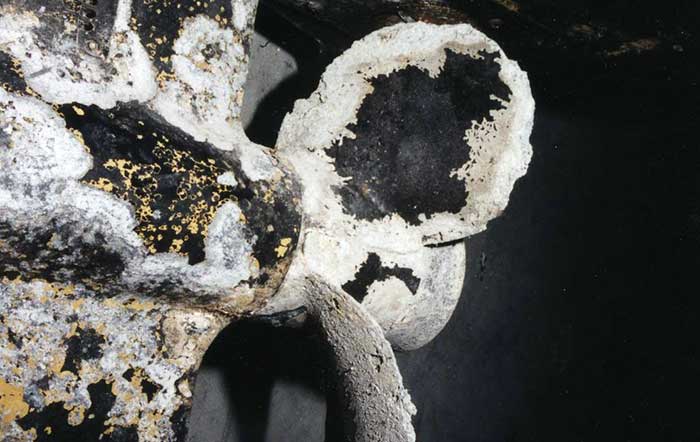
Stray-current corrosion can destroy a sterndrive in a matter of weeks. (Photo: BoatUS Marine Insurance)
Note that for stray-current corrosion to occur, there must be two isolated metals submerged in seawater (with no bonding system installed). For example, if a radio ground plate is connected to the battery negative and an alternator positive conductor faults to an ungrounded engine block, the prop shaft and prop can be destroyed in a matter of days. However, if the two wetted metals are interconnected with a bonding or grounding conductor, then stray-current corrosion is virtually impossible because the bonding/grounding conductor would short-circuit the errant voltage source. Preventing stray-current corrosion requires boat owners to periodically check their 12-volt electrical system for loose wires or poor or inadequate connections, especially in bilge areas, which can be full of seawater that acts as an electrolyte.
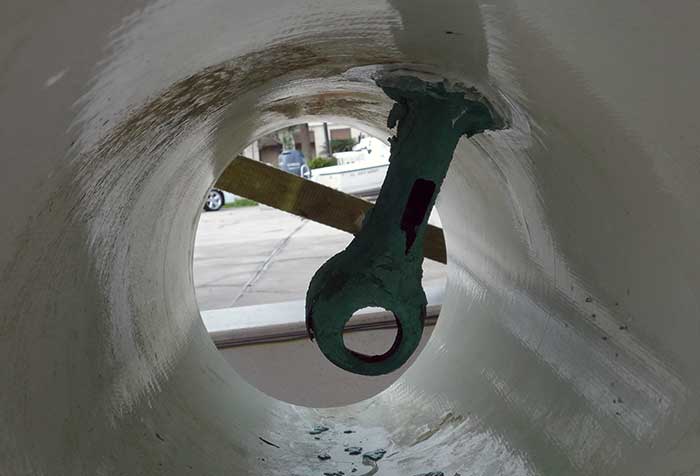
An errant 12-volt wire destroyed this bow thruster. (Photo: James Coté)
Problem No. 3: Oxygen-Depletion Attack
Also known as crevice corrosion, oxygen-depletion attack can catch unsuspecting boaters unaware. It attacks in crevices and other hidden areas, and it most commonly attacks stainless steel, which the typical layperson believes should be impervious to corrosion. However, while some grades of stainless steel are resistant to oxygen-depletion attack, others are quite susceptible. Using 316L stainless steel under the waterline, for example, would be akin to using pine for your wood decks instead of teak.
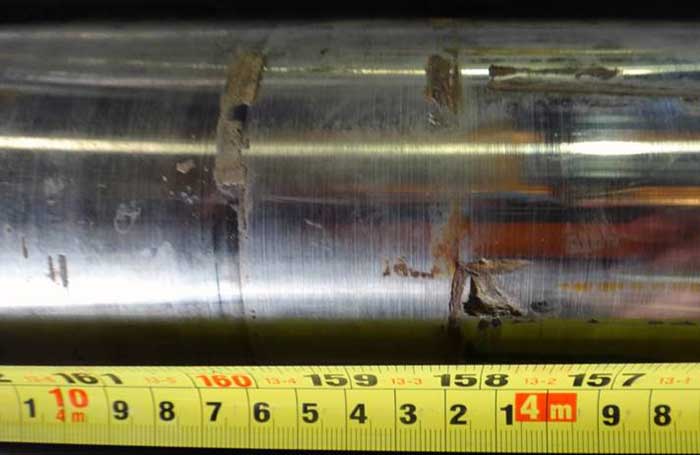
This stainless-steel propshaft is a victim of crevice corrosion; without a supply of fresh oxygen, even stainless steel is vulnerable. (Photo: James Coté)
The characteristic of stainless steel that makes it "stainless" is a chemical reaction of the metal at its surface with the oxygen in its environment. This reaction results in a film that protects the surface from corrosion. However, if part of the surface is in contact with low-oxygen stagnant water, then this part loses its protective film and becomes less noble than the remaining metal surfaces; it then behaves like a sacrificial anode. For example, if a vessel lies dockside for months without its prop shafts turning over, the water under the cutless bearing becomes stagnant. Pitting may develop, which causes the shaft to weaken; under power, it could snap while underway and potentially flood the boat.
Fortunately, there are grades of stainless steel whose compositions have been altered to reduce susceptibility to crevice corrosion; these grades of stainless steel are resistant to oxygen-depletion attack. The bottom line is that most stainless steel, including the typical 316L type, can corrode underwater, and thus, for the most part, shouldn't be used there.
Preventing corrosion damage to submerged metals may seem, in the planning stages, to be a technically complicated task, but enacting such a plan is relatively straightforward. Virtually all corrosion issues can be resolved in the pre-crisis stage through proper design, adequate cathodic protection, and a minimal amount of monitoring and maintenance.
